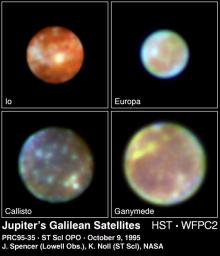
|
Hubble Gallery of Jupiter’s Galilean Satellites
- Click the image above for a larger view
- Full-Res JPEG (600 x 700) (44.8 kB)
- Full-Res TIFF (600 x 700) (527.3 kB)
Caption:
This is a Hubble Space Telescope "family portrait" of the four largest moons of Jupiter, first observed by the Italian scientist Galileo Galilei nearly four centuries ago. Located approximately one-half billion miles away, the moons are so small that, in visible light, they appear as fuzzy disks in the largest ground-based telescopes. Hubble can resolve surface details seen previously only by the Voyager spacecraft in the early 1980s. While the Voyagers provided close-up snapshots of the satellites, Hubble can now follow changes on the moons and reveal other characteristics at ultraviolet and near-infrared wavelengths.
Over the past year Hubble has charted new volcanic activity on Io's active surface, found a faint oxygen atmosphere on the moon Europa, and identified ozone on the surface of Ganymede. Hubble ultraviolet observations of Callisto show the presence of fresh ice on the surface that may indicate impacts from micrometeorites and charged particles from Jupiter's magnetosphere.
Hubble observations will play a complementary role when the Galileo spacecraft arrives at Jupiter in December of this year.
Background Info:
This image and other images and data received from the Hubble Space Telescope are posted on the World Wide Web on the Space Telescope Science Institute home page at URL http://oposite.stsci.edu/ .
Cataloging Keywords:
| Name | Value | Additional Values |
|---|---|---|
| Target | Jupiter | Callisto, Europa, Ganymede, Io |
| System | Jupiter | |
| Target Type | Planet | Satellite |
| Mission | Hubble Space Telescope (HST) | Galileo, Voyager |
| Instrument Host | Hubble Space Telescope | Galileo Orbiter |
| Host Type | Space Telescope | Orbiter, Flyby Spacecraft |
| Instrument | Wide Field/Planetary Camera 2 (WFPC2) | |
| Detector | ||
| Extra Keywords | Atmosphere, Color, Impact, Infrared, Magnetosphere, Ultraviolet, Volcano | |
| Acquisition Date | ||
| Release Date | 1998-05-02 | |
| Date in Caption | ||
| Image Credit | JPL/NASA/STScI | |
| Source | photojournal.jpl.nasa.gov/catalog/PIA01261 | |
| Identifier | PIA01261 | |
